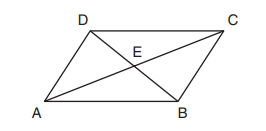Now that I'm caught up with the current New York State Regents exams, I'm revisiting some older ones.
More Regents problems.
Geometry Regents, June 2011
Part I: Each correct answer will receive 2 credits.
11. In the diagram below, parallelogram ABCD has diagonals AC and BD that intersect at point E.
Which expression is not always true?
1) ∠DAE ≅ ∠BCE
2) ∠DEC ≅ ∠BEA
3) AC ≅ DB
4) DE ≅ EB
Answer: 3) AC ≅ DB
In a parallelogram, the opposite angles are always congruent, so eliminate Choice (1).
In any pair of intersecting lines, the Veritcal Angles are always congruent, so eliminate Choice (2).
In a parallelogram, the diagonals bisect each other but they are NOT NECESSARILY congruent. They are only congruent in rectangles. This eliminates Choice (4) and identifies (3) as the answer.
12. The volume, in cubic centimeters, of a sphere whose diameter is
6 centimeters is
1) 12π
2) 36π
3) 48π
4) 288π
Answer: 2) 36π
Volume of a Sphere is 4/3 π r3. You were given D = 6, so r = 3.
V = 4/3 π (3)3 = 36π
8. The equation of line k is y = 1/3 x − 2. The equation of line m is −2x + 6y = 18. Lines k and m are
1) parallel
2) perpendicular
3) perpendicular
4) neither parallel nor perpendicular
Answer: 1) parallel
Parellel lines have the same slope but different y-intercepts. If the slopes and the y-intercepts are the same, then it is the same line. If the slopes are inverse reciprocals (that is, they have a product of -1, or are vertical and horizontal), they are perpendicular. Otherwise, it would be Choice (4) which is everything else.
Line k has a slope of 1/3 and a y-intercept of -2.
Rewrite line m into slope-intercept form:
-2x + 6y = 18
6y = 2x + 18
y = 1/3 x + 3
The slopes are the same but it isn't the same line, so they are parallel.
14. What are the center and the radius of the circle whose equation is
(x − 5)2 + (y + 3)2 = 16?
1) (−5,3) and 16
2) (5,−3) and 16
3) (−5,3) and 4
4) (5,−3) and 4
Answer: 4) (5,−3) and 4
The equation for a circle is given by the formula (x - h)2 + (y - k)2 = r2, where (h,k) is the center of the circle and r is the radius.
Since r2 = 16, then r = 4. Eliminate Choices (1) and (2).
Since the signs are flipped, (y + 3) means the point is at -3.
15. Triangle ABC has vertices A(0,0), B(3,2), and C(0,4). This triangle
may be classified as
1) equilateral
2) isosceles
3) right
4) scalene
Answer:2) isosceles
Eliminate Choice (3). Every right triangle MUST be one of the other three choices as well.
Line AC has a length of 4. You can use the Distance formula to find AB and BC, but since y = 2 is halfway between y = 0 and y = 4, we can see that the distance from (0,0) to (3,2) must be the same as (0,4) to (3,2).
So the triangle is isosceles, which is Choice (2).
More to come. Comments and questions welcome.
More Regents problems.
I also write Fiction!You can now preorder Devilish And Divine, edited by John L. French and Danielle Ackley-McPhail, which contains (among many, many others) three stories by me, Christopher J. Burke about those above us and from down below. Preorder the softcover or ebook at Amazon. Also, check out In A Flash 2020, by Christopher J. Burke for 20 great flash fiction stories, perfectly sized for your train rides. Available in softcover or ebook at Amazon. If you enjoy it, please consider leaving a rating or review on Amazon or on Good Reads. |
 |
 |

















No comments:
Post a Comment